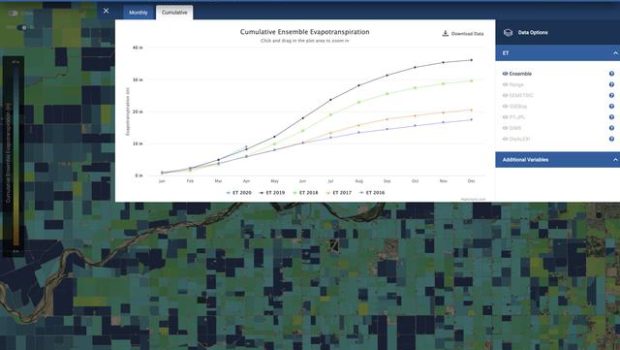Technology aims to get better water data to farmers » Albuquerque Journal
https://www.ispeech.org/text.to.speech
A screenshot of the OpenET technology in development to make satellite data more accessible for farmers and water managers. (Courtesy Environmental Defense Fund)
ALBUQUERQUE, N.M. — Another year of persistent drought has made it clear New Mexico farmers need more tools to make the most of scarce water.
Technology in development aims to get NASA and Google satellite data in the hands of farmers and water managers across the West.
The OpenET project is an initiative of the Environmental Defense Fund, Desert Research Institute, NASA and Google Earth Engine, as well as several university researchers.
................................................................
ET stands for evapotranspiration – the process by which water evaporates from soil and plants after irrigation.
The technology would fill a data gap by pinpointing how much water is lost to evapotranspiration, said Maurice Hall, associate vice president of EDF’s water program and an advisor for the project.
“Thousands of people across New Mexico and the West get up every morning and work to make the water show up where it’s needed,” Hall said. “To make these good decisions as good as they can be, those people need good information.”
The technology uses satellite data to calculate temperature changes and measure how much water evaporates across large areas or individual fields. The team is combining those existing models with local weather data to ensure accuracy.
The web interface would use Google Earth Engine to display data. Farmers could zoom into a particular field and get years of evapotranspiration data.
Hall said the team wants to make satellite data accessible without the cost of consultants or expensive technology. The data would be free for small-scale users.
“The goal is that a farmer in northeast New Mexico is looking at the same data that Reclamation and state planners are looking at,” he said. “It can be useful for farmers making daily irrigation decisions and people crafting long-term water plans for entire river basins.”
Irrigated agriculture accounts for about 76% of New Mexico’s water use, according to the Office of the State Engineer. Water use trends are similar in other Western states.
With a database like OpenET, farmers and water managers could measure water saved by updating irrigation systems or planting different crops.
“Farmers will be able to install new low-head sprinklers on their center pivot irrigations, and then go back in and see how much water savings they got from implementation,” Hall said. “Then you compare that with yield data, and you can see how much to invest in conservation measures.”
The platform is being tested by farmers and researchers, and will be made available to the public in 2021.
Theresa Davis is a Report for America corps member covering water and the environment for the Albuquerque Journal.








Gloss